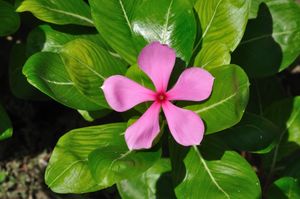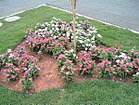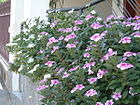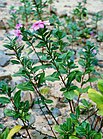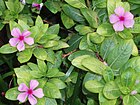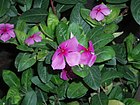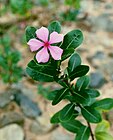Note: This is a project under development. The articles on this wiki are just being initiated and broadly incomplete. You can Help creating new pages.
Catharanthus roseus - Sada Bahar
Vinca is a genus of flowering plant in the family Apocynaceae. It is native and endemic to Madagascar, but grown elsewhere as an ornamental and medicinal plant, It is a source of the drugs vincristine and vinblastine, used to treat cancer. It was formerly included in the genus Vinca as Vinca rosea.
Uses
Blood pressure, Lung cancer, Leukaemia, Dysentery, Diarrhoea, Hodgkin’s lymphoma, Diarrhea, Bleeding hemorrhoids
Parts Used
Chemical Composition
Indole, Indoline alkaloids, Ajmalicine, Lochnerine, Serpentine[1]
Common names
| Language | Common name |
|---|---|
| Kannada | Nitypushpa |
| Hindi | Sadabahar |
| Malayalam | Shavam Naari |
| Tamil | NA |
| Telugu | NA |
| Marathi | NA |
| Gujarathi | NA |
| Punjabi | NA |
| Kashmiri | NA |
| Sanskrit | NA |
| English | Periwinkle, Madagascar periwinkle |
Properties
Reference: Dravya - Substance, Rasa - Taste, Guna - Qualities, Veerya - Potency, Vipaka - Post-digesion effect, Karma - Pharmacological activity, Prabhava - Therepeutics.
Dravya
Rasa
Tikta (Bitter), Kashaya (Astringent)
Guna
Laghu (Light), Ruksha (Dry), Tikshna (Sharp)
Veerya
Ushna (Hot)
Vipaka
Katu (Pungent)
Karma
Kapha, Vata
Prabhava
Habit
Identification
Leaf
| Kind | Shape | Feature |
|---|---|---|
| Simple | opposite | The leaves are lobed or unlobed but not separated into leaflets |
Flower
| Type | Size | Color and composition | Stamen | More information |
|---|---|---|---|---|
| Unisexual | 2-4cm long | pink to red, white | 5 | Flowers Season is June - August and the flower is radially symmetrical |
Fruit
| Type | Size | Mass | Appearance | Seeds | More information |
|---|---|---|---|---|---|
| General | 10–50 mm | The fruit is dry and splits open when ripe | - | {{{6}}} |
Other features
List of Ayurvedic medicine in which the herb is used
Where to get the saplings
Mode of Propagation
How to plant/cultivate
Vinca or Periwinkle will grow in range of light conditions, from full sun to shade. They will do well in average soils. They are both heat and drought tolerant. This makes Vinca ideal in hot, dry parts of the country where other flowers will wither and wilt.[3]
Commonly seen growing in areas
Photo Gallery
References
External Links
- Ayurvedic Herbs known to be helpful to treat Blood pressure
- Ayurvedic Herbs known to be helpful to treat Lung cancer
- Ayurvedic Herbs known to be helpful to treat Leukaemia
- Ayurvedic Herbs known to be helpful to treat Dysentery
- Ayurvedic Herbs known to be helpful to treat Diarrhoea
- Ayurvedic Herbs known to be helpful to treat Hodgkin’s lymphoma
- Ayurvedic Herbs known to be helpful to treat Diarrhea
- Ayurvedic Herbs known to be helpful to treat Bleeding hemorrhoids
- Herbs with Leaves used in medicine
- Herbs with Flowers used in medicine
- Herbs with common name in Kannada
- Herbs with common name in Hindi
- Herbs with common name in Malayalam
- Herbs with common name in English
- Habit - Ornamental herb
- Index of Plants which can be propagated by Seeds
- Index of Plants which can be propagated by Cuttings
- Herbs that are commonly seen in the region of Ornamental plant in gardens
- Herbs that are commonly seen in the region of Under trees and bushes
- Herbs that are commonly seen in the region of Parks and cemeteries
- Herbs
- Ayurvedic herbs that don't have seed photos
- Apocynaceae
